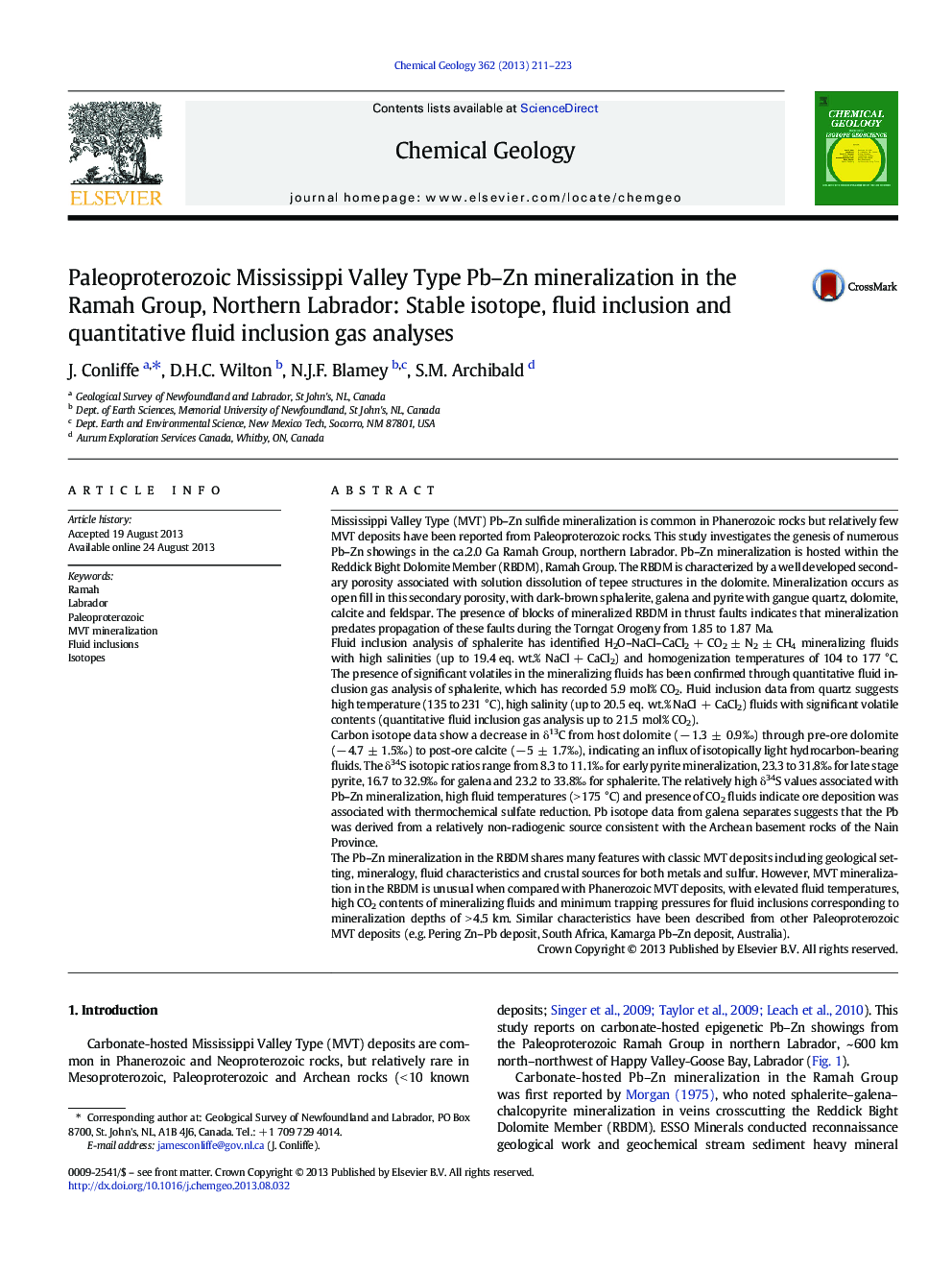| کد مقاله | کد نشریه | سال انتشار | مقاله انگلیسی | نسخه تمام متن |
|---|---|---|---|---|
| 6436771 | 1637608 | 2013 | 13 صفحه PDF | دانلود رایگان |

- Pb-Zn showings in the ~Â 2Â Ga Ramah Group are described.
- Showings share features with classic MVT deposits.
- Mineralization is associated with high temperature carbonic fluids and TSR.
- Similar unusual characteristics to other Paleoproterozoic MVT deposits
Mississippi Valley Type (MVT) Pb-Zn sulfide mineralization is common in Phanerozoic rocks but relatively few MVT deposits have been reported from Paleoproterozoic rocks. This study investigates the genesis of numerous Pb-Zn showings in the ca.2.0 Ga Ramah Group, northern Labrador. Pb-Zn mineralization is hosted within the Reddick Bight Dolomite Member (RBDM), Ramah Group. The RBDM is characterized by a well developed secondary porosity associated with solution dissolution of tepee structures in the dolomite. Mineralization occurs as open fill in this secondary porosity, with dark-brown sphalerite, galena and pyrite with gangue quartz, dolomite, calcite and feldspar. The presence of blocks of mineralized RBDM in thrust faults indicates that mineralization predates propagation of these faults during the Torngat Orogeny from 1.85 to 1.87 Ma.Fluid inclusion analysis of sphalerite has identified H2O-NaCl-CaCl2 + CO2 ± N2 ± CH4 mineralizing fluids with high salinities (up to 19.4 eq. wt.% NaCl + CaCl2) and homogenization temperatures of 104 to 177 °C. The presence of significant volatiles in the mineralizing fluids has been confirmed through quantitative fluid inclusion gas analysis of sphalerite, which has recorded 5.9 mol% CO2. Fluid inclusion data from quartz suggests high temperature (135 to 231 °C), high salinity (up to 20.5 eq. wt.% NaCl + CaCl2) fluids with significant volatile contents (quantitative fluid inclusion gas analysis up to 21.5 mol% CO2).Carbon isotope data show a decrease in δ13C from host dolomite (â 1.3 ± 0.9â°) through pre-ore dolomite (â 4.7 ± 1.5â°) to post-ore calcite (â 5 ± 1.7â°), indicating an influx of isotopically light hydrocarbon-bearing fluids. The δ34S isotopic ratios range from 8.3 to 11.1â° for early pyrite mineralization, 23.3 to 31.8â° for late stage pyrite, 16.7 to 32.9â° for galena and 23.2 to 33.8â° for sphalerite. The relatively high δ34S values associated with Pb-Zn mineralization, high fluid temperatures (> 175 °C) and presence of CO2 fluids indicate ore deposition was associated with thermochemical sulfate reduction. Pb isotope data from galena separates suggests that the Pb was derived from a relatively non-radiogenic source consistent with the Archean basement rocks of the Nain Province.The Pb-Zn mineralization in the RBDM shares many features with classic MVT deposits including geological setting, mineralogy, fluid characteristics and crustal sources for both metals and sulfur. However, MVT mineralization in the RBDM is unusual when compared with Phanerozoic MVT deposits, with elevated fluid temperatures, high CO2 contents of mineralizing fluids and minimum trapping pressures for fluid inclusions corresponding to mineralization depths of > 4.5 km. Similar characteristics have been described from other Paleoproterozoic MVT deposits (e.g. Pering Zn-Pb deposit, South Africa, Kamarga Pb-Zn deposit, Australia).
Journal: Chemical Geology - Volume 362, 20 December 2013, Pages 211-223